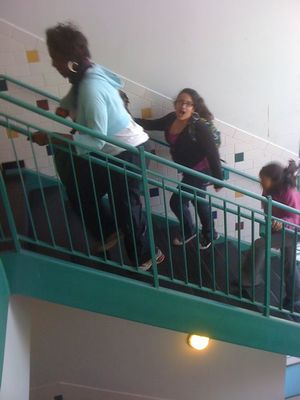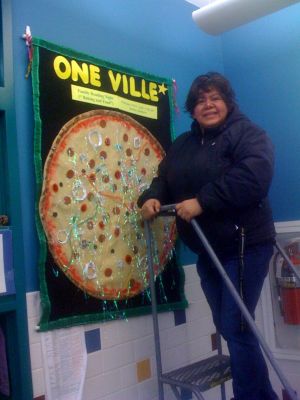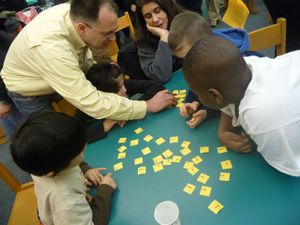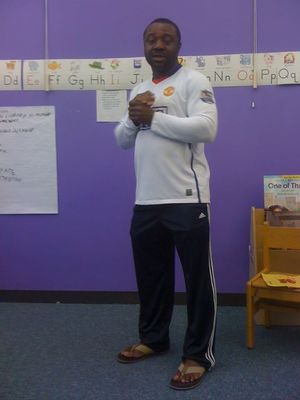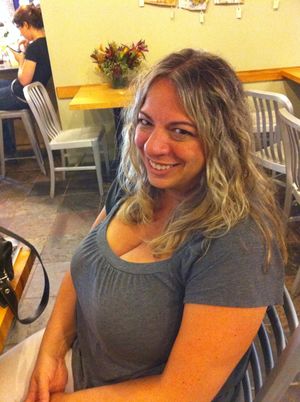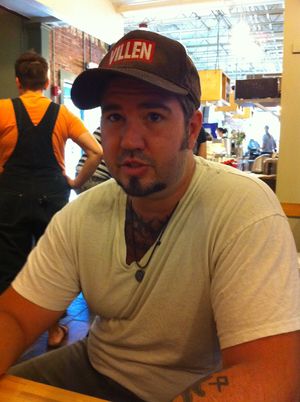Reading Nights
From Oneville Wiki
Here’s where we’ll talk about how we figured things out, over time. Our main goal is to share our “ahas” -- the moments when we figured something important out.
We’ll share our COMMUNICATION AHAS. In the process of doing the work, what did the working group realize about improving communications in education?
IMPLEMENTATION AHAS. In the process of doing the work, what did the working group realize about implementing these innovations?
TURNING POINTS. Moments when we redirected the project accordingly, after a communication aha or an implementation aha.
We’ll share visual examples and use photos or videos of people whenever we can!
ADD MORE PHOTOS OF CONNECTORS AND VIDEOS OF THE DIAGRAMS, TO BRING THIS ALIVE. (CONSIDER VIDEO INTERVIEWS W/ SOME CONNECTORS TOO!)
In 2009 when we began our work, the K-8 Healey had 4 historically separated programs: a magnet K-6 program drawing disproportionately middle-class families from Somerville; a "Neighborhood" K-6 program disproportionately enrolling low income and immigrant families living around the school, including in the housing development a few steps away; a Special Education program, also disproportionately enrolling low income students of color and immigrants; and a middle school (7-8).
In fall 2009, with parents from across the first three programs whose children shared a Kindergarten hallway at the Healey, we began creating Reading Nights to link parents in face to face efforts to build relationships and share information on reading with young children. (ONE PHOTO HERE)
Several of these parents formed the early core of the parents who would continue to work on schoolwide communication for two straight years. We worked together on creating a monthly multilingual coffee hour and holding some parent dialogues. In 2010-11, a subset of bilingual parents forged forward to create the Parent Connector Network.
From the beginning, we wrestled with the particular issue of connecting English-speaking parents and staff with parents speaking other languages -- and with getting information written in English translated. Over time, we realized the particular need for improving the communication infrastructure for translation and interpretation and focused fully on the Parent Connector Network in winter/spring 2011. But let us share the story of how we got there! It's a story of friendships sparking school improvements and vice versa.
SCHOOLWIDE COMMUNICATION EFFORT 1: READING NIGHT
In fall 2009, Mica and Consuelo, both parents in the Kindergarten hallway at the Healey School, met at a parent coffee hour with the principal and discovered a mutual interest in starting conversations across language and program. We immediately started talking to other parents about the idea of “OneVille” -- in this case, linking families who shared a pretty divided school -- and a design partnership at the Healey began to sprout!
In conversations with the principal and other parents in the hallway, we came up with the idea of holding a monthly Reading Night designed to link parents across programs in communications about supporting children’s literacy. We sat with other parents in the PTA room and talked about what might pull us together. Tracy and Dave, Maria, Jen, Carrie, Consuelo, Michelle, and others started brainstorming a first Reading Night focused on baking words (Tracy, a parent in the hallway’s “Neighborhood” classroom, had a cookie business and her husband Dave worked in a pizza restaurant).
In doing the work of holding Reading Nights, we built friendships between us parents that would make a difference in the years to come -- and we encountered a bunch of schoolwide communication issues that would shape our thinking about the “infrastructure” needed at the Healey!
COMMUNICATION AHA: the success of any school event relies on school-home communication.
To get parents in the hallway out to Reading Nights, we had to advertise events in multiple languages and test ways of getting people back to school in the evenings. A listserv linked the school’s K-6 magnet program parents (though less so, the program’s lower-income and recent immigrant parents) but not the Special Education and "Neighborhood" programs. To include everyone, we moved forward with paper and face to face communication.
We put up multilingual signs outside of the classroom doors, where parents would see them. Some did, but not all parents dropped off their kids at school themselves. Consuelo's giant pizza, put up on the wall a few days before each Reading Night, worked particularly well to attract kids -- who then brought their parents!
Had we known that we could record calls on the school's "robocall" system (ConnectEd) to target parents in their language, perhaps we could have used that to invite more people! It wasn't until the following year, with a new principal, that we realized we could help shape the content of robocalls. (But this most direct channel-home was often used only for the "most important" of communications, so we may not have been allowed to use it. We only used it twice in these two years -- once to invite people to a schoolwide dialogue and once to invite parents to PTA night.)
Face to face invitations on the playground before school were often the thing that brought some parents to Reading Night. But face-to-face invitations were really time-consuming, and our energy for standing outside to invite parents personally to events waned over the year. Beyond sending fliers home and putting up Consuelo’s pizza, at teachers’ urging we continued to announce Reading Nights to kids in classrooms, who would then invite their parents. One of our most well-attended Reading Nights involved an entire “Neighborhood” class, who did a play together with their teacher.
COMMUNICATION AHA: Sharing info and building relationships with busy parents often requires face to face contact. But this is the very sort of contact that is most time-consuming!
IMPLEMENTATION AHA: If face to face outreach one by one is draining the resources of volunteers, try reaching those clustered in one place -- in this case, kids!
Reading Nights were in part about getting families excited about reading together in new ways (parents told us their children left talking all night about reading). But as it turned out, what many parents most needed (or wanted!) was a chance to talk quietly to other parents. We learned to make time in Reading Nights to get parents together on the side to talk together about our children’s reading struggles, as our children did activities. (This required parents who could interpret for others.) In part from listening to parents who ended up taking care of the kids, missing the parent-to-parent conversation, and getting frustrated, we realized parents really needed opportunities to become and make friends.
As we tried to share out tips from Reading Nights, though, we again realized the need for better communication infrastructure for connecting parents to each other to share information. We tried to post our reading tips as paper sheets on a hallway bulletin board (we used Google Translate, which garbled some of the words) and we stuck the same fliers in every backpack. But this never turned into a conversation that ran in between our Reading Nights -- whoever didn’t come in person didn’t really benefit.
COMMUNICATION AHA: We still need to figure out ways to get information to parents if they don’t show up to face-to-face events.
Prepping for Reading Night took more time than we wanted, because we tended to prepare materials from scratch (LINK TO CONSUELO'S DOCUMENT HERE).
But at the same time, we knew our kids loved the events, and the work did create friends and leaders among us -- one organizing parent (Maria) later became the head of the PTA and two others (Tracy and Dave) its vice presidents, and others (Michelle) won spots on the School Site Council in a year that would turn out to be very important for the Healey’s future. We saw other benefits to parent-parent connections: since our first Reading Night focused on sharing words about baking, (PHOTO) one mom got word of Tracy’s cookie business -- and hooked her up to a reporter in the Boston Globe for press!
We burned out on Reading Night after holding about six of them that year, because it took too much face to face work to create materials from scratch; we sort of reached the outer limit of volunteer time and energy. We also realized that since we weren’t experts on reading, it was more effective for us to focus on venues for gathering parents to talk, period, than on guiding other parents in the content of teaching reading. We also didn’t yet know how to “seed” events so they would replicate without us. But we knew we had created an important space for parents to gather together -- and the friendships we made carried us through our next innovations.
IMPLEMENTATION AHA: If prepping face to face events from scratch takes too much volunteer time from people, they lose momentum. At the same time, the slog of preparing for face to face events can build friendships that can seed real change.
SCHOOLWIDE COMMUNICATION EFFORT 2: MULTILINGUAL COFFEE HOUR
While designing Reading Nights, we also focused on improving an existing "slot" for parent-parent and parent-administrator communication: the typically English-dominated "coffee hours" with the principal, held monthly on Friday mornings in the PTA room. Relatively few immigrant parents came regularly to this event, and English-speaking parents almost always dominated the conversation.
In partnership with the principal in fall 2009, we created a slot for a multilingual coffee hour model, a brainstorm of Consuelo (PHOTO), always committed to finding creative ways of empowering and including immigrant parents. We thought about having language-specific coffee hours but the principal asked for a combined coffee hour, which in the end offered its own benefit -- valuing multilingualism. In the multilingual coffee hour, parents voluntarily translated for other parents wanting to ask questions and hear information from the principal. Enjoying the sound of multiple languages became part of the event.
[JPEG HERE OF COFFEE HR INVITE]]
The experience quickly clued us into a key local resource:
MAIN COMMUNICATION REALIZATION: The massive local resource of parent bilingualism!
At several points over that school year and the next, we considered combining the multilingual coffee hour back into the "regular" coffee hour with the principal. In fall 2010, the Healey's next principal first suggested that every coffee hour should de facto be multilingual. But, then he decided to keep a distinct "multilingual" coffee hour. Since typical coffee hours were still dominated by questions and rapidly-launched comments from English-speaking parents, it still felt important to have a space focused actively on multilingual communication. The multilingual coffee hour with the principal is now an established place where people take extra time for translation and purposefully amplify languages other than English, by ensuring that speakers of other languages get priority in asking and answering questions. Main needs: a coffee pot; some Brazilian sweet bread; the principal; and parents with questions or ideas!
(ADD MINI COMMENT BLURB OR VIDEO INTERVIEW HERE WITH LUPE OR IRMA and DAVE, ON WHAT IT HAS MEANT TO HAVE AN EXPLICITLY MULTILINGUAL COFFEE HR? ANA, CAN YOU PLAN TO GET THIS?)
SCHOOLWIDE COMMUNICATION EFFORT 3: PARENT-PARENT ISSUE DIALOGUES
New community developments at the Healey in 2009-10 shaped our next ahas about needed improvements to communication infrastructure. Halfway into the 2009-10 school year, the Somerville School Committee put on its agenda a key task: deciding whether to integrate the Healey's magnet and "Neighborhood" K-6 programs. In response, we used our multilingual coffee hour for a number of parent dialogues and “Q and A with the principal” dialogues to facilitate conversation about this choice. link to OV blog post here We also held an organized parent dialogue on a Saturday at the nearby Mystic Housing Development’s activity center link to blog post here.
In our work to support such organized parent dialogues, we realized how irregular it was for parents to just speak to each other across "groups" about their children's education. Many parents had never talked to parents from the other programs, or across lines of language or social class. It became important later in the Healey's unification debate to be able to report that everyone we talked to - across lines of class, race/ethnicity, and language - said they wanted a more rigorous learning experience for their children.
In the parent dialogue work, we also realized again some structural barriers of communication that held back many parents from being fully involved in the school. School committee members used the magnet program's listserv to advertise school committee meetings about the Unification debate. The parents who came to the meetings to speak their minds were disproportionately those on the listserv. Those on the listserv also emailed the superintendent or principal regularly with their opinions about whether the programs should integrate. Three months into the debate, when we walked around the nearby Mystic Development (the housing project literally down a flight of stairs from the school) to invite parents to a school committee meeting on the upcoming decision, we realized that many parents – again, those not on the listserv -- were unaware that the possibility of integration was even up for debate at their school at all. Some parents, particularly immigrant parents struggling to communicate in a new language, were so “out of the loop” of school information that they didn’t understand there were multiple programs at the school to begin with.
In the end, the School Committee voted to "unify" the Healey's K-6 programs and hired a consultant to steer that process through the following school year. Parents were invited into the process as partners.
TURNING POINT: With the Healey in the midst of brainstorming all sorts of changes to its everyday structures, we parents focused for 2010-11 on improving infrastructure for schoolwide communication -- and on including immigrant parents in particular.
